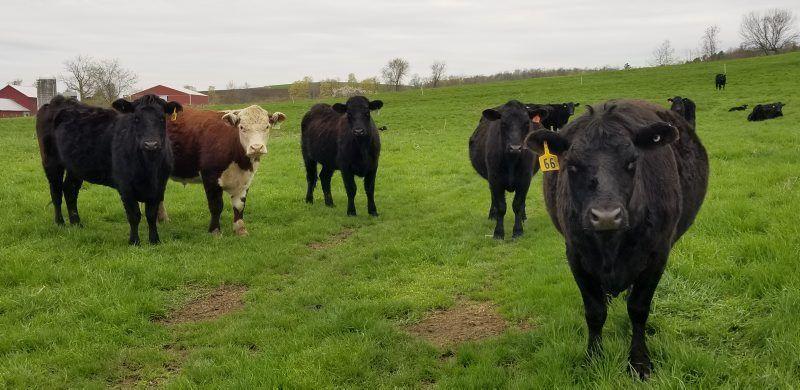 Crossing beef cattle with dairy cattle is nothing new; however, some new information has come to light.
Crossing beef cattle with dairy cattle is nothing new; however, some new information has come to light.
Joe Emenheiser, a livestock Extension educator with the University of Connecticut, presented a webinar exploring the new frontiers of beef and dairy crossbreeding.
“Even though this topic has been discussed and practiced before, we’re in a new realm in animal breeding and animal nutrition,” Emenheiser said.
“Beef x dairy” means that the sire is first and the cow is second.
“Close to 20% of beef is dairy beef — a dairy bred cow that is slaughtered,” Emenheiser said.
He added that because of volatility in fluid milk prices and the increased availability of sexed semen, “many dairy producers are able to satisfy their need for replacement heifers with fewer purebred matings.”
By crossbreeding their lower-performing dairy cows to beef bulls, producers can develop a new revenue stream.
Crossbreeding By the Numbers
Emenheiser said that not much research has been completed about the genetic selection of beef bulls for crossbreeding with dairy breeds, the feeding protocols for crossbred calves and other management strategies to develop a good product.
“Everything boils down to the necessary replacement rate of heifers,” he said. “Typically, 30-40% is the average rate. That depends upon longevity — the years or lactations that the cow has in the system, the goals for herd expansion or contraction.”
He added that if the herd is progressing in its genetics, the youngest animals will be genetically better than older ones.
Producers need to focus on more than the bulk tank.
“It’s not simply genetics for milk production if the cow isn’t able to reproduce as quickly or is subject to metabolic disorders,” Emenheiser said. “There’s an index of desirable traits that need to be weighed.”
For the sake of herd health and the farm’s sustainability, it is more important to look at the whole animal and the animal’s effect on the rest of the farm.
“The number of purebred dairy bull calves is decreasing in the last eight years,” Emenheiser said. “The share of dairy heifers born from sexed semen is increasing. As a consequence, the dairy heifers from unsexed semen are decreasing. Beef cross is taking more and more of the market share from lower performing cows to the extent that the overall percentage of calves born is nearly 50% beef cross in the U.K. We’re not there in the U.S. but we very well could be.”
Breeding among different dairy breeds has increased, with fewer farms going for Holstein/Holstein breeding, for example.
“The concept is simple,” Emenheiser said. “The bottom line is the best animals are above average and the rest are below. The best are in the category to move forward with sexed semen. Up to 70% of the herd could not be needed for replacement. They could be used for non-sexed semen or to use for beef-dairy crosses.”
He believes that the most powerful tool in animal breeding is hybrid vigor, or heterosis.
“Different traits have different heritabilities and different responses to heterosis,” Emenheiser said. “Those that are more heritable have a lower response to heterosis. Those that are low heritable have a higher response to heritability, the variation attributable to genetics and is passed from one generation to the next.”
Developing Beef From Dairy
To develop high-quality, profitable meat, producers need to focus on quality grade for tenderness, juiciness, flavor, maturity and marbling; yield grade, including the percent of closely trimmed retail cuts — not dressing percentage, backfat thickness, internal fat, ribeye area and carcass weight; and production efficiency, which involves average daily gain, feed conversion and income versus expense.
“It’s important to start from the standpoint of products and markets,” Emenheiser said. “We need to make sure it is high quality, consistent and ultimately profitable for everyone in the chain from conception to consumption.”
Many dairymen will process cows that have passed their prime lactation; however, “as an animal gets older, its meat is less tender,” Emenheiser said.
He added that it takes four times longer for dairy breeds to achieve the desired weight, which can make it less tender and less flavorful. That is why producers need to pay more attention to the animal’s condition when non-beef breeds are present in its genetics. It gains at a different rate than a pure beef-bred animal.
“Different typed animals even within in the beef breeds have different curves for growth,” Emenheiser said. “For a Holstein, the frame is longer and the muscle is not a lot in dairy.”
He concluded, “It comes down to harvesting these animals in the appropriate point in their growth curve. The longer we keep an animal, we will experience a decrease of gain and it will take more pounds of feed to produce a pound of life weight.”
Though dairy animals can produce great beef, it takes longer and the process can be less efficient. Still, crossing beef with dairy breeds can produce an additional revenue stream to bolster the dairyman’s livelihood when milk prices falter and feed costs increase.
Emenheiser said that research is underway to look at the differences in management and how they related to beef and dairy crosses. For example, dairy calves are conventionally bottle-fed but beef calves are not.
“That can have a huge bearing on the rest of its life,” he said. “A lot of management can boil down to nutrition, a major source of variation. It can have an impact on growth.”
Source: lancasterfarming.com











